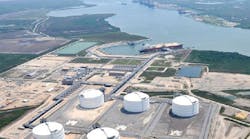Oil and Natural Gas Infrastructure Investments Will Be Boon to US GDP, Jobs
Investment of $890 billion over the next 12 years in oil and gas transportation and storage infrastructure will move the U.S. toward a trade balance in energy and dramatically impact the U.S. economy, according to a new study from IHS Global Inc., an information and analytics firm.
In the past five years, IHS noted, the U.S added nearly 1.2 million barrels per day of crude oil production capacity. The nation now leads with world in natural gas production at 65 billion cubic feet per day. And the U.S. has added 500,000 barrels of oil equivalent per day of natural gas liquids (NGLs) since 2008.
Dramatic increases in domestic crude oil and natural gas production, the study finds, are resulting in a continuing period of major investments that include pipelines, rail, ships, storage facilities, refineries and facilities to liquefy natural gas. Between 2014 and 2020, an average of more than $80 billion will be invested annually in petroleum infrastructure, IHS predicts. After 2020, that investment will moderate but the research firm expects direct capital investment will still be nearly $60 billion by 2025.
IHS noted that for decades, energy infrastructure investments in the U.S. had been made on the assumption that the nation would be importing an “ever increasing percentage of its energy demand in the form of crude oil, refined products, natural gas liquids and liquefied natural gas.” That meant moving imported energy from the coasts inland. But now, with the development of unconventional oil and natural gas fields in the middle of the country and farther east, huge investments are being made to move domestic oil and gas from the center of the U.S. to the Gulf Coast and the Eastern seaboard.
About 60% of the investment will be in crude oil and natural gas gathering systems and direct production support facilities, IHS forecasts. There will be a “heavy weighting of investments towards liquids (crude oil and NGLs) over the next 5 years driven by wide oil-to-gas price spreads,” but IHS said the investments would then shift back to natural gas as prices recovered.
What will be the economic impact of this investment in energy infrastructure? In its “base case scenario,” IHS forecasts that the infrastructure investment will contribute $94 billion to U.S. GDP each year from 2014 to 2025. It will also result in support for almost 900,000 jobs, labor income of $59 billion and government revenues of more than $21 billion.
If oil and gas production was 20% higher than in its base scenario, IHS added, the energy investments would contribute $120 billion annually to GDP, support more than 1.1 million jobs, produce labor income of $75 billion and provide government revenues of $27 billion.
While all areas of the country will receive investment, IHS said, the south is likely to see the greatest investment – an average of $41.5 billion annually while $14.1 billion would go to the West, $11.8 billion to the Midwest and $6.4 billion to the Northeast.




